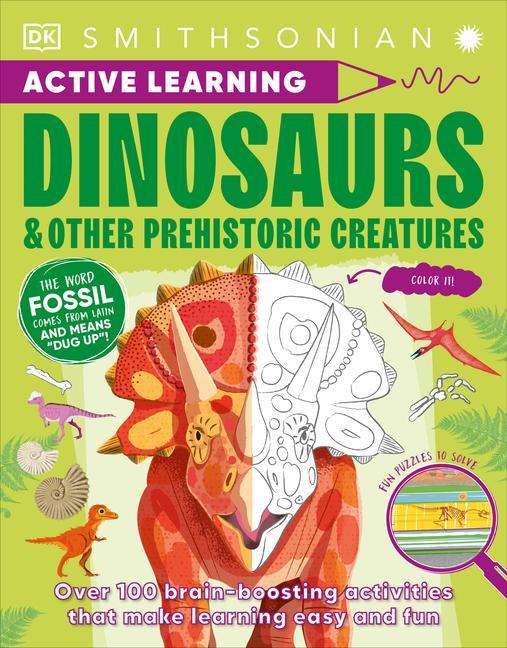Active Learning Dinosaurs And Other Prehistoric Creatures : More Than 100 Brain- Boosting Activities That Make Learning Easy And Fun by DK

View book: Active Learning Dinosaurs And Other Prehistoric Creatures : More Than 100 Brain- Boosting Activities That Make Learning Easy And Fun
Active Learning Dinosaurs and Other Prehistoric Creatures: More Than 100 Brain-Boosting Activities That Make Learning Easy and Fun
Are you looking for an exciting way to spark your child’s interest in dinosaurs and other prehistoric creatures? Look no further than this amazing activity book! Designed for kids aged 8-12, this book offers over 100 engaging activities and puzzles that will make learning a breeze.
Forget boring textbooks and monotonous lectures. This activity book is packed with fun and interactive challenges that will keep your child entertained for hours. From solving mazes and tangles to cracking codes and playing matching games, there’s something for every young paleontologist to enjoy. Plus, there are quizzes, sudoku, odd-one-out, and coloring activities to further enhance their learning experience.
But this book is not just about having fun. It’s also a valuable educational resource. With detailed illustrations and informative write-in activities, kids can expand their knowledge and explore the fascinating world of dinosaurs and other prehistoric creatures. It’s perfect for both classroom learning and home study, making it an ideal tool for teachers and parents alike.
Whether your child is a super-keen learner or a bit reluctant when it comes to studying, this captivating dinosaur book is guaranteed to make learning enjoyable. So, grab a copy and watch as the prehistoric world comes to life!
“What If Humans Keep Evolving? Exploring the Future of Our Bodies”
In this fascinating article, we will explore the concept of human evolution in a different light. While Charles Darwin’s theory of evolution introduced the idea that humans have undergone changes over time to better adapt to their environment, we will delve deeper into how our bodies may continue to evolve in the future. Let’s imagine what could happen if our bodies kept evolving!
An Ever-Changing Scenario
Since Darwin’s publication in 1859, it has been widely accepted that humans have evolved and adapted in order to survive in diverse environments. Our current physical traits, such as our complex brains, bipedal locomotion, and tool-making abilities, have contributed to our success as a species. However, the process of evolution is ongoing and has not ceased.
Some remarkable examples of recent human evolution can be found among the Bajao people of Southeast Asia. These individuals possess unusually large spleens, which allows them to stay underwater for extended periods, up to 15 minutes. This adaptation has enabled them to thrive in their specific aquatic environment.
Another significant example is lactose tolerance in certain populations. In the past, humans could not digest lactose (the sugar present in milk) beyond infancy. However, due to genetic changes, some humans can now digest lactose as adults. This highlights that our bodies are still evolving and adapting to different dietary requirements.
Environmental Influences
The future appearance of humans will largely depend on our present choices and the state of our environment. If individuals who prioritize healthy eating and regular exercise have children, it is likely that these traits will be passed down and become more prevalent in the population over time. Consequently, future generations may be more physically fit.
Similarly, environmental factors like pollution and global warming can influence human evolution. If pollution intensifies, humans might develop stronger immune systems or more efficient detoxification mechanisms to combat the effects of pollutants. In the case of global warming, humans may develop adaptations like thinner skin or larger ears to better cope with the rising temperatures.
The Future Human Form
The potential future evolution of humans holds intriguing possibilities. Improved nutrition has already resulted in an increase in height, but there is no guarantee that this trend will continue. In a million years, humans could become incredibly tall with smaller heads.
Additionally, our modern habits, such as frequent use of smartphones, could also shape our evolution. It is conceivable that stronger and more dexterous finger muscles, improved visual acuity, and hand-eye coordination may develop as a result of our reliance on small screens. However, these speculations are based on assumptions as evolution is influenced by numerous factors and remains unpredictable.
Only Time Will Tell
Human evolution is a complex and ongoing process. Predicting how it will unfold is challenging. We can only observe and speculate on potential changes based on current knowledge. Time will reveal the true course of our evolution.
In conclusion, the concept of human evolution is a captivating subject. Whether our bodies will continue to evolve and how they will change in the future remain intriguing mysteries. Through studying the patterns of the past and observing the impact of present choices and environmental conditions, we can gain insights into what the future might hold for the ever-evolving human species.
Did you know that the earliest human ancestors lived in Africa around 7 million years ago? For more information about evolution, please check out our extensive article playlist on the topic. Remember, only time will tell what awaits us in the fascinating journey of evolution!
Today’s featured sketch goes to eight-year-old Karma. Keep exploring and having fun! Until next time, it’s Dr. Binox, signing off!







Leave a Reply